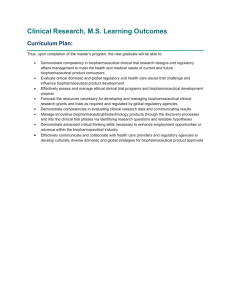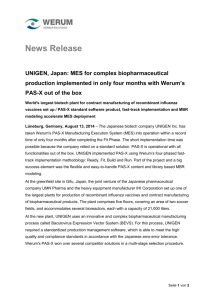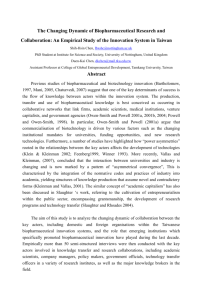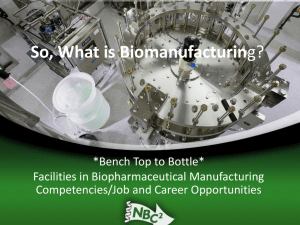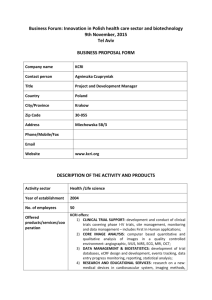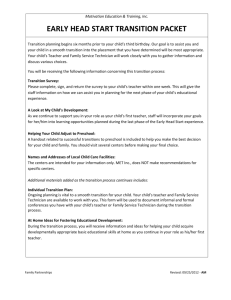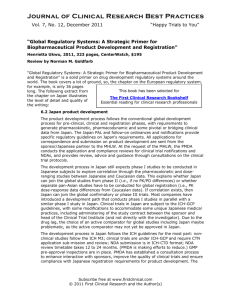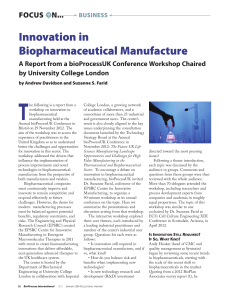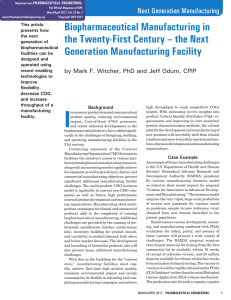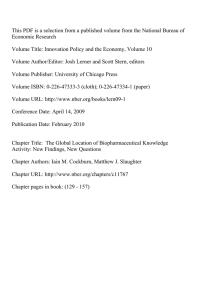ERT 420 BIOPHARMACEUTICAL ENGINEERING
advertisement
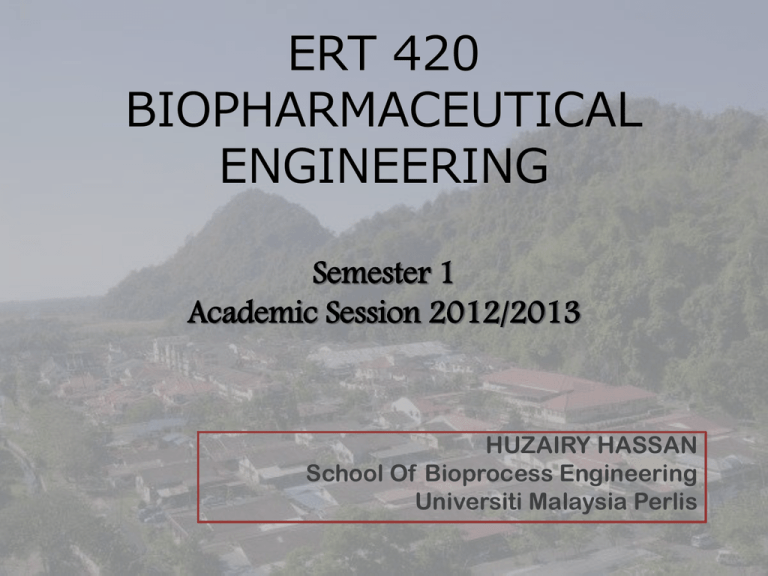
ERT 420 BIOPHARMACEUTICAL ENGINEERING Semester 1 Academic Session 2012/2013 HUZAIRY HASSAN School Of Bioprocess Engineering Universiti Malaysia Perlis BIOPHARMACEUTICAL FACILITIES The Drug Discovery, Development and Approval Process for Biopharmaceuticals (Biologics) DISCOVERY DEVELOPMENT Clinical Trials Phase I Phase II Phase III Test Population Laboratory and animals studies 20 to 100 healthy volunteers 100 to 500 patient volunteers 1,000 to 5,000 patient volunteers Purpose Assess safety biological activity and formulations Success Rate 5,000 compounds evaluated Activities Cell line construction, Cell banking Determine safety and dosage Evaluate effectiveness, look for side effects Confirm effectiveness, monitor adverse reactions from longterm use 5 enter trials Process development, assay development, process optimization, scale-up, cGMP manufacture File application File NDA at FDA Discovery / Preclinical Testing File IND at FDA Testing Phase Manufacturin LAUNCH Review process / approval Phase IV Additional postmarketing testing required by FDA 1 approved Commercial manufacture Years 6.5 1.5 2 3.5 1.5 =15 Approximate Cost $350M $70M $100M $200M $80M = $1B Research & Development (Pre-Clinical): Discovery Research, Bioinformatics, Lab Safety Operations: Process/Product, Development, Manufacturing & Production Finance & Administration: Quality: Clinical Research: Quality Control & Assurance Clinical Research, Regulatory Affairs Finance, Business Development, Administration, Information Systems, Legal, Facilities Management VP of Research/Development VP of Operations Discovery Research Process/Product Development Scientific Director Associate Scientific Director Principal Scientist Senior Scientist Scientist II Scientist I Senior Research Associate Research Associate Bioinformatics Scientist/Engineer Analyst/Programmer Molecular Modeler Lab Facilities Facility Manager/Supervisor (Animal Sciences) Veterinarian Lab Assistant/Glasswasher Director of Process/Product Development Process Development Supervisor Process Development Associate Process Development Technician Direction of Quality Medical Director Quality Control (QC) Clinical Research Chemistry QC Analyst QC Technician Microbiology Manufacturing & Production Manufacturing Supervisor Manufacturing Associate Manufacturing Technician (Operator) Manufacturing Instrumentation/ Calibration Technician Clinical Research Manager QC Analyst QC Technician Quality Assurance (QA) QA Manager/Supervisor QA Documentation Specialist QA Documentation Coordinator Regulatory Affairs Manager of Regulatory Affairs Regulatory Affairs Associate Clinical Data Manager/Associate VP of Finance & Administration Finance Chief Financial Advisor Accounting Manager Accounting Clerk Business Development Director of Business Development Administration Director of Human Resources Human Resources Representative Safety Manager Purchasing Agent/Buyer Receptionist Administrative Assistant Information Systems Manager of Information Systems Systems Analyst Analyst/Programmer Legal Patent / IP Attorney Facilities Management Facilities Manager Facilities Technician Shipper/Receiver Biomanufacturing • • • • • • Commercial scale biomanufacturing involves the building of a facility to produce the biopharmaceutical following upstream processing and downstream processing equipment and process SOPs. Samples are tested in quality control microbiology and quality control biochemistry laboratories to make sure the molecule has been produced correctly. cGMPs guide the process of manufacturing a biopharmaceutical and everything is documented. For ex: A new protein requires a facility to be prepared for its production and 400 to 600 individuals are hired, usually at least 50% are technicians. The largest bioreactor in such a facility is 25,000 liters. Once constructed and commissioned, the facility’s equipment and process SOPs must undergo validation. All instruments must be calibrated (instrumentation/calibration or metrology often part of facilities) and the set up, maintenance and use of each piece of equipment is logged. Environmental Health and Safety (EH&S) requirements are of central importance. 21 CFR Part 210 and 211 is highly enforced during the making of an FDA approved protein for commercial production and widespread use (quality assurance). Biopharmaceutical Manufacturing Departments • Facilities/Metrology • Validation • Environmental Health and Safety (EH&S) • QA • Upstream Processing • Downstream Processing • QC Microbiology • QC Biochemistry • Process Development Facilities in Gray Space Facilities General Cleanroom Design • • • • • • • • • HEPA filters in ceiling Exhaust vents on floor Seamless and rounded floor to wall junctions Readily accessible corners Floors, walls, and ceilings constructed of smooth hard surfaces that can be easily cleaned Limited equipment, fixtures and personnel Layout of equipment to optimize comfort and movement of operators Pressure Differentials between rooms Airlocks to control air balance Facilities Production Clean Rooms FS209 ISO 14644-1 Cleanroom Cleanroom classification classification ≥0.5um particles/m3 Viable Microbes (cfu/m3) Ave Airflow Velocity (fpm) Air changes/hr 100,000 8 3,520,000 100 5-10 5-48 10,000 7 352,000 10 10-15 60-90 1000 6 35,200 7 25-40 150-240 100 5 3,520 1 40-80 240-480 Facilities HEPA Filters High Efficiency Particulate Air Minimum particle collection efficiency: 99.97% for 0.3µm diameter particles. Disposable Filter made of pleated borosilicate glass microfiber Biological Safety Cabinets Class 100 A microbiologist performing influenza research within a biosafety cabinet Facilities Pressure Differentials • Used to maintain airflow in the direction of higher cleanliness to adjacent less clean areas • A minimum of 10-15 Pascals should be maintained between the aseptic area and an adjacent room with a different clean room classifications (doors open) Facilities Airlocks Permit the passage of objects and people into a clean room. Consists of two airtight doors in series which do not open simultaneously. Spray down materials with 70% IPA before placing in the airlock ISOPROPYL ALCOHOL Powerful disinfectant and antiseptic Mode of action: denatures proteins, dissolves lipids and can lead to cell membrane disintegration Effectively kills bacteria and fungi What is not killed by IPA? So, use what? Why are aqueous solutions are preferred? Gowning Certification QC Microbiology – Environmental Monitoring Laser Particle Counter Air Samplers Environmental (Air) Monitoring Particles Viable Microbes (Bioburden) Microbial Air Sampler Laser Particle Counter Environmental (Air) Monitoring Laser Particle Counter (particles/cubic meter) Microbial Air Sampler (colony forming units/ cubic meter) www.safety-epa.com/history_mold_air_sampling.htm Utilities Water*: 200,000 to 300,000 liters of water are used per day in a commercial biopharmaceutical manufacturing facility. • WFI: sand, diatomaceous earth, charcoal filter, water softener, RO, uv treatment, distillation, and constant circulate in a loop at 80 ⁰C. WFI piped to production equipment for CIP and SIP processes and for making media and buffers for production. • DI and USP water used in QC labs (less pure); chilled potable water used for cooling. Gasses: • Air, oxygen, and carbon dioxide to keep cells happy, nitrogen, and helium (to check for leaks in equipment). HVAC: Heating, ventilation, and air conditioning in clean rooms and gray spaces. Waste*: • Cells (sludge) - heat to very high temperatures and to sewer; liquids (media and buffers) treat with base and acid in a series of (three) tanks until neutral pH and to sewer. *Piped with 316L stainless dairy piping, triclover clamps, and valves. Services for Drug Development • Cell Banking and Characterization • Product Characterization • Process Characterization (Residual Testing) • Vaccines and Cell Therapy • Viral Clearance • Stability Testing • In Vivo Biosafety • In Vivo and In Vitro Potency Testing • Biosimilar Testing • Discovery and Development • Polyclonal Antisera Production • Consulting and Project Management VALIDATION PARAMETERS The following are validation parameters for key utilities and services GMP autoclaves. Overkill cycle, 60 minutes at 121°C at 15 psi. No survival of Bacillus stearothermophilus spores at a population of 106 Pure steam generator. Condensed pure steam meets USP WFI specifications. Endotoxin <0.125 EU/ml, and microbial content <1 Cfu/100 mL. Depyrogenation oven. 60 min. cycle at 250°C. <100 0.5 μm particles/ per ft3 of 0.5 μm size. Minimum of 3 log endotoxin reduction. No survival of Bacillus subtilus at a population of 106. Ultra high quality water. <10 ppb of metals (such as Ni, Cu, and CO), <10 PPB of organics; <0.03 EU/mL of endotoxin; and <1Cfu/100mL. Resistivity 15-18 megohm. Meets and exceeds USP specifications for water for injection (WFI). HVAC and environmental baseline. Controlled areas except wash and microbial production (10,000 particles/ft3/min) and wash room and microbial production (100,000 particles/ft3/min). < 25 viable organisms/10 ft3 of air; temperature 23±3°C; and humidity 40-60%. • Bench scale vs pilot For batch processes, in the pharmaceutical industry for example, bench scale is typically conducted on samples 1–20 kg or less, whereas pilot scale testing is performed with samples of 20–100 kg. Pilot Plant – Overall Flow Plan Biopharmaceutical Pilot plant General facility layout for a flexible, biopharmaceutical pilot facility with a 30,000-ft2 area. AL = airlock; EN = entry airlock; EX = exit airlock;O = GMP depyrogenation oven; A = GMP autoclave; Utilities = UHQ water, pure steam, plant steam; Entry Corr = entry corridor to cell culture facility; Exit Corr = exit corridor from cell culture facility; QC = quality control; Mol Biol = molecular biology laboratory; RE = research laboratory entry/exit; PE = production facility entry/exit; PG = pregowning room; Jan = janitorial supply room; DR = dark room; PG = pregown room. THANK YOU Reference • http://people.deas.harvard.edu/~jones/lab_arch/nano_facilities/hepa.gif • http://news.thomasnet.com/images/large/451/451402.jpg • www.bio-link.org • Koichi, K., et al. Biopharmaceutical Manufacturing Facilities (2009). IHI Engineering Review, Vol 42, No. 2. • http://www.bioasset.in/biopharmaceutical-service.html
